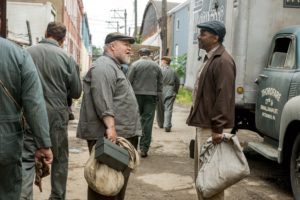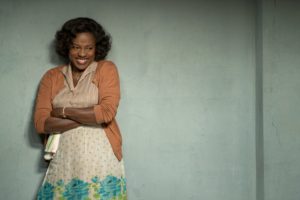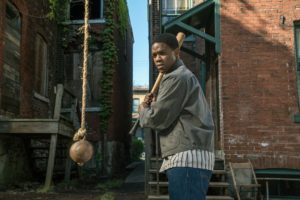
Based upon the August Wilson play, Fences, tells the story of an African American father struggling with race relations, his own personal history and raising a family during the 1950’s. Although plays are a more heavily dialog-based art form than films, cinematographer Charlotte Bruus Christensen did not feel it affected her shooting. Although she saw the play and “loved it,” her thoughts on the cinematography started out with the screenplay.
Christensen had long conversations about adapting a play into a film with Denzel Washington who directed the film as well as starring in it alongside Viola Davis. Other than opening up the play by using multiple locations, they ultimately came to the conclusion of not doing too much to make it different. Instead they concentrated on telling the story.
“The decision was to stay true to what the play was, but with the cinematic language that I could provide with the camera,” stated Christensen. “And also, Denzel said, ‘Now we can actually do close-ups. We can see what the person whose back is to the audience is thinking.’ It’s those small details that make the difference.”
In terms of the look for the film, it was “not a faded movie.” The film needed to stay true to life at that time. The red brick walls in the backyard, had to stay red. It was not a documentary, but there was a truthful approach to the colors that they enhanced a bit.
Fences was a tough story that was essentially about love, although the way the main character Troy expresses that love to his wife and kids was not always in a pleasant way. It was important that the representation of the story was not too bleak or cold.

The spring weather in Pittsburgh was a challenge. Shooting in locations that were basically coming down were also a challenge, due to health and safety issues. They could not rig to the buildings, so that restricted what they could do “to light and silk and control the look of the movie.”
“It’s always a challenge when you shoot everything on location and you have a restricted time schedule. Obviously Denzel starring in this movie and directing takes a bit of extra time. He was in almost every scene until the very end,” shared Christensen. “We would do a couple of takes and he would go in and check that out, but pretty quickly we found our routine. He let us all take responsibility to make this work.”
Christensen felt she was on the same page as Washington, so she would go about setting the lights and camera. If she occasionally doubted a choice, she would get the director for a decision, but generally there was a trust between them.
The naturalistic look was achieved by the choices of lighting, anamorphic lenses and 35mm camera. Every decision made was based upon the story.
In regards to the lighting, Washington had one note: to make it truthful. He did not want commercial lighting with a lot of glittery backlights, but rather soft lighting. The idea was to “think documentary, but bring a cinematic look to it.” Even the backyard lighting was not natural. They used 20Ks and bounced the light to keep a consistent look.
Christensen and Washington both felt 35 mm film was right for the film because so much of the movie was about texture and close-ups of the faces. From the start, Washington wanted to shoot anamorphic, a decision that the cinematographer wanted to consider because of the small spaces they were working in.

“Because of the narrow depth of field, you can’t focus close-up. You have to have people a bit further away,” explained Christensen. “You have to have a lot more light. These little houses didn’t have a lot of windows. If they had windows, there was another house just outside. For many technical reasons, it was a big challenge to shoot anamorphic.”
Christensen wanted to show Washington other options until he mentioned that someone had once told him that anamorphic was a performance lens that had something to do with the rack focus from background to foreground.
“I suddenly understood that he was talking about the distortion you have on these lenses. He felt that when you pull that focus to a face, the image draws your attention more than just the focus,” revealed Christensen. “Every technical choice was discussed and taken from the story aspects. It was so right to shoot on 35.”
For Christensen this was a very special project, made that way by Washington who made sure the film was true to August Wilson’s writing.
Christensen concluded, “Denzel gets what he wants in a way that always made sense to us. It was amazing to feel that every decision, every passion, every emotion you are in, is because he really cared about the story. That was an amazing experience to be part of.”





